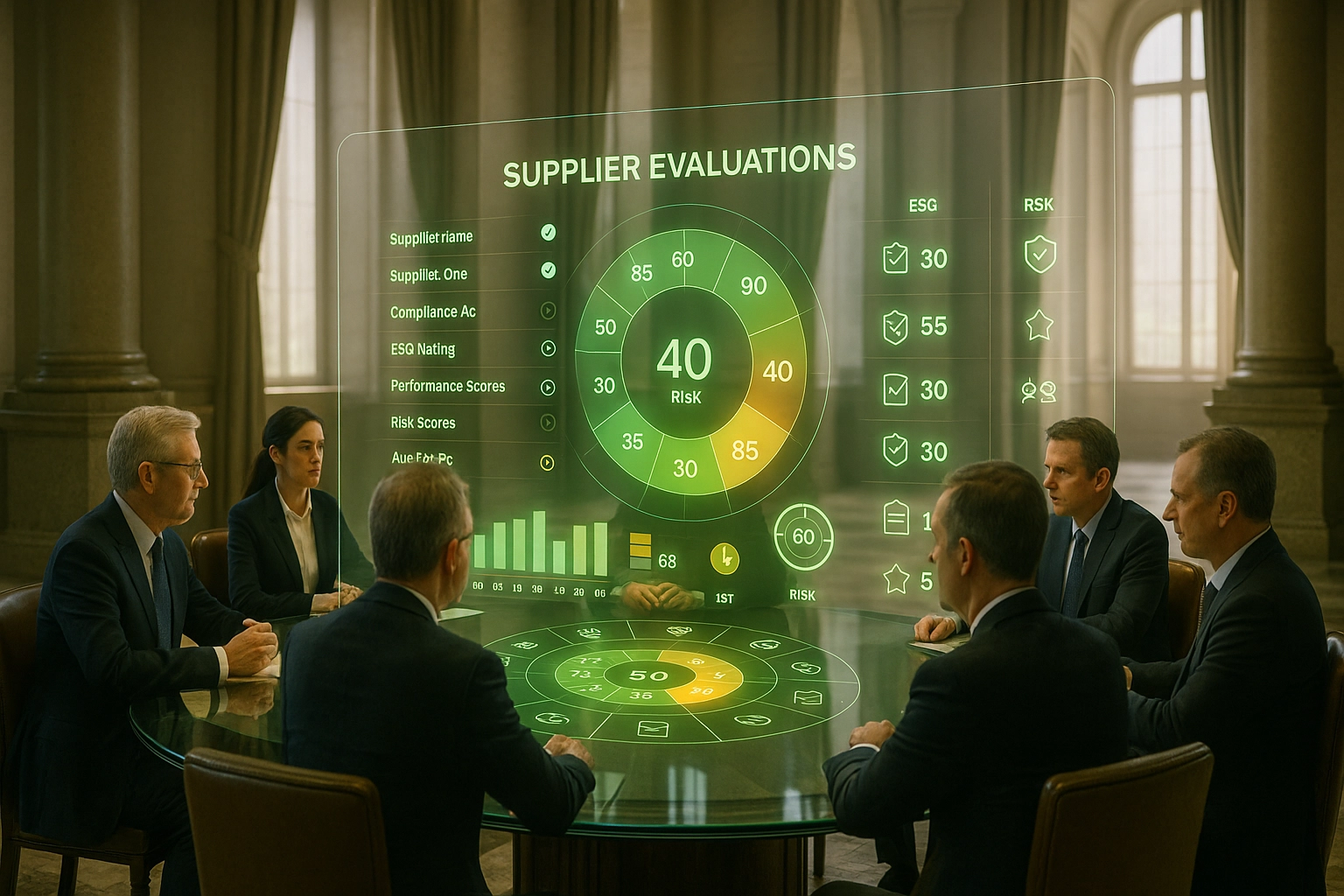Supplier Evaluation Journey: Optimizing Multi-Regulatory Data Collection

The complexity of third-party evaluation is intensifying as regulatory requirements multiply. This reality calls for a reform of internal processes and the adoption of collaborative workflows that are essential to ensure compliance while strengthening operational resilience.
Optimizing the evaluation journey involves a structured methodology that streamlines document collection, improves supplier quality, and significantly reduces “supplier fatigue.” This context calls for a collaborative transformation, illustrated by concrete industry examples.
Key Steps in the Collaborative Evaluation Journey
Optimizing the evaluation journey begins with a rigorous structuring of the phases linking your organization to each third party. Defining these steps enables precise management of supplier performance throughout the contract lifecycle. Each phase must be clear, documented, and adapted to the sector’s specifics—whether public procurement, industrial purchasing, or supply management in retail.
Collaboration between internal teams (procurement, compliance, finance, legal) and external providers is the cornerstone of successful collaborative evaluation. A sequential and tailored workflow minimizes document overload, avoids duplication, and increases responsiveness during supplier audits. This methodology builds on the TPRM expertise developed by Aprovall to structure each phase of the evaluation effectively.
Multi-Regulatory Risk Mapping and Evaluation Criteria
The first step involves building a detailed third-party map while defining evaluation criteria. This includes classifying partners by criticality, role in the value chain, and associated risks, alongside incorporating multiple regulatory frameworks: DORA, NIS 2, CSRD obligations, public procurement code for the public sector, construction certifications for the building industry. This approach enables proactive risk management early in the process while avoiding document overload.
In the social housing sector, for instance, distinguishing between technical and administrative providers helps prioritize and tailor evaluation grids (administration, safety, lead times, sustainability). In industry, segmentation by regulatory exposure (ICPE, licensed sites) supports risk management and criterion selection. Sector-specific customization ensures evaluations reflect each third party’s actual risk profile.
In e-commerce, where the volume of partners is high, mapping combined with targeted criteria selection lightens the workload and improves feedback quality during supplier audits. The collaborative DORA and NIS 2 evaluation solutions illustrate how regulation becomes an operational asset.
Optimize your third-party evaluation with a collaborative, sector-specific approach.
Streamlining Document Collection and Reducing Supplier Fatigue
Document collection is a key challenge in the evaluation workflow. Poorly managed, it leads to delays, duplication, and disengagement from strategic partners—threatening operational resilience. It also exhausts internal teams. Collaborative and intelligent systems are thus essential for smooth collection processes.
Excessive evaluation questionnaires create a heavy administrative burden. A centralized portal with automatic completeness checks improves supply chain management. Automated reminders and targeted notifications ensure smooth follow-ups without overloading recipients, thereby enhancing supplier performance.
Dynamic Forms and Real-Time Moderation
Dynamic forms automatically adapt to the partner’s profile, avoiding unnecessary requests. Identifying segment-specific legal requirements upfront ensures relevant document collection and reduces pressure on partners. This approach is particularly effective in sectors under heightened regulatory scrutiny, where deep evaluation of all suppliers is mandatory.
In public procurement, inserting interim validation points reduces errors found in final controls. Automatically sending a Kbis extract or compliance certificate, approved by an internal lead, accelerates the evaluation journey. This process is inspired by best practices in automated due diligence to maximize team productivity.
Flexible Renewal Management and Periodic Updates
One-time collection is no longer sufficient in light of evolving regulations and critical incident prevention. A schedule of periodic updates based on supplier criticality ensures proper tracking and traceability of commitments. Clear and fluid renewal requests eliminate the “black hole” effect often experienced by procurement teams.
In the industrial sector, annual subcontractor requalification campaigns facilitate financial, technical, and regulatory oversight. This aligns with European regulations requiring continuous third-party monitoring for cybersecurity. Real-time monitoring solutions automate this surveillance while reducing administrative burden.
Oversight, Analysis, and Feedback: Toward Continuous Governance
A successful supplier evaluation journey goes beyond regulatory compliance. It creates a proactive oversight system that promotes continuous optimization and early warning detection—engaging all stakeholders. Leveraging collected data becomes a major driver of progress, especially under DORA and NIS 2 monitoring obligations.
Consolidated dashboards offer early detection of weak signals and a clear view of supplier performance, useful for annual reporting and supplier audits. In retail, such tracking supports agile referencing decisions and enhances logistics strategies. This approach integrates third-party risk mapping methodologies for a holistic view.
Relevant Indicators and Accessible Reporting
Using composite indicators—including compliance status, processing costs, response rate, and shared satisfaction—enriches dialogue between executives, procurement, and third parties. In construction, sharing these metrics with subcontractors improves delay control and strengthens public sector third-party governance.
User-specific reporting (executive, manager, operational staff) enhances clarity. Interpreting discrepancies alongside actionable plans supports supplier quality improvements. This aligns with AI-driven third-party governance to automate analysis and anomaly detection.
Sector Feedback: Shared Practices and ROI
Some organizations have adopted systematic learning loops after each evaluation cycle. In social housing, regular partner feedback led to a simplified and more complete submission process. This showcases the benefits of shared due diligenceas a strategic lever.
In industry, a “supplier committee” enabled sites to harmonize evaluation criteria, generating economies of scale and a more stable supply chain. This virtuous cycle reinforces resilience and meets growing third-party oversight demands from European regulations.
Redefine your third-party governance strategy through a collaborative approach that turns compliance into a competitive edge.
Toward a Lasting Methodology: A Practical Optimization Guide
Building a lasting collaborative evaluation methodology means going beyond document-based compliance to create a true third-party governance ecosystem. This transformation depends on advanced technology and active stakeholder engagement. Refocusing the evaluation workflow on real business challenges—not just regulatory formality—makes the process stronger, more flexible, and more valuable.
In the public sector, where 65% of procurement leaders cite supplier failure as a top 2025 risk, training teams on DORAand NIS 2 is essential to keep public contracts compliant. Incorporating third-party governance best practices helps facilitate this organizational shift.
Smart Automation and Decision Support Tools
Smart automation is revolutionizing collaborative evaluation through predictive analytics and anomaly detection—confirmed by recent Deloitte sector studies identifying AI as a key TPRM efficiency lever. Intelligent workflows enable real-time monitoring of 450,000 third parties worldwide.
In retail, automation is vital in managing supply chain vulnerabilities—responsible for 30% of data breaches per Verizon’s 2025 DBIR. This digital transformation relies on real-time dashboards to continuously monitor third-party partners.
Performance Metrics and ROI
Supplier performance metrics include regulatory compliance, processing costs, response rates, and satisfaction levels. This allows objective evaluation of the evaluation journey‘s effectiveness and proves the value of collaboration. This addresses Aprovall’s key findings, where 38% of companies experienced major disruptions from third parties.
In construction, measurable performance indicators for subcontractors improve project timelines and certification traceability. This approach reflects TPRM fundamentals and uses automated due diligence to enhance team productivity while maintaining high control levels.
Toward Sustainable Collaborative Governance
The shift toward sustainable third-party governance involves adopting a holistic approach that integrates ESG criteria into evaluations. This evolution turns regulatory pressure into a competitive advantage, especially in sectors under DORA and NIS 2 continuous monitoring. The ESG strategy for supply chains becomes a key differentiator.
This shift is backed by data showing 78% of procurement teams will have sustainability objectives by 2025, with the public sector leading at 86% vs. 82% for private. This aligns with France’s National Sustainable Procurement Plan (PNAD) 2022-2025, targeting 100% of public contracts with at least one environmental clause by end-2025.
Third-party governance thus becomes a strategic lever to meet new responsible purchasing demands. Companies that incorporate decarbonization criteria into their supplier evaluation anticipate compliance while strengthening their competitive edge. This collaborative approach transforms regulatory constraints into shared innovation with third-party partners.
Transform your third-party evaluation with a proven methodology that combines regulatory expertise and technology for high-performing collaborative governance.
These articles might interest you
-
 18 August 2025Reindustrialization: Why Mastering Third Parties Is Now a Strategic ImperativeSecteurFrance’s reindustrialization is underway. Driven by the ambitions of the France 2030 plan, the ecological transition, and economic sovereignty challenges, it’s about much more than simply bringing factories back onto national soil. It requires a deep rethink of sourcing, evaluation, and supplier management processes. Restoring independence and economic sovereignty has become a major strategic issue […]
18 August 2025Reindustrialization: Why Mastering Third Parties Is Now a Strategic ImperativeSecteurFrance’s reindustrialization is underway. Driven by the ambitions of the France 2030 plan, the ecological transition, and economic sovereignty challenges, it’s about much more than simply bringing factories back onto national soil. It requires a deep rethink of sourcing, evaluation, and supplier management processes. Restoring independence and economic sovereignty has become a major strategic issue […]Read more
-
 15 April 2025Supplier Evaluation in the Public Sector: A Strategic Governance ChallengeSecteurThe public sector accounts for a significant portion of economic activity in France and involves a large number of contract holders. As such, public sector actors face critical challenges in managing supplier relationships—especially since third-party qualification has become a cornerstone of public procurement strategies. Beyond basic oversight, it now forms part of a broader approach […]
15 April 2025Supplier Evaluation in the Public Sector: A Strategic Governance ChallengeSecteurThe public sector accounts for a significant portion of economic activity in France and involves a large number of contract holders. As such, public sector actors face critical challenges in managing supplier relationships—especially since third-party qualification has become a cornerstone of public procurement strategies. Beyond basic oversight, it now forms part of a broader approach […]Read more
-
 20 May 2025Deploying a TPRM Platform in Private Companies: Proven Methodology for Effective Third-Party GovernanceSecteurIn a context where TPRM programs require executive-level support to succeed, deploying a TPRM platform is a major strategic challenge. While deployment in the public sector has its own regulatory specificities, multi-site private companies face distinct organizational challenges that call for a tailored methodological approach. This structured methodology transforms third-party evaluation into a true third-party governance lever, going beyond mere documentation compliance to […]
20 May 2025Deploying a TPRM Platform in Private Companies: Proven Methodology for Effective Third-Party GovernanceSecteurIn a context where TPRM programs require executive-level support to succeed, deploying a TPRM platform is a major strategic challenge. While deployment in the public sector has its own regulatory specificities, multi-site private companies face distinct organizational challenges that call for a tailored methodological approach. This structured methodology transforms third-party evaluation into a true third-party governance lever, going beyond mere documentation compliance to […]Read more
-
 14 January 2025ESG and Supply Chain: Emerging Challenges for 2025SecteurLa transformation ESG révolutionne la supply chain en 2025, devenant un impératif stratégique pour toute entreprise moderne. La directive CSRD, entrée en vigueur depuis janvier 2024, impose aux entreprises européennes une transparence totale sur leurs impacts environnementaux et sociétaux. Cette évolution réglementaire majeure s’accompagne de nouvelles exigences comme le CBAM (Carbon Border Adjustment Mechanism) et […]
14 January 2025ESG and Supply Chain: Emerging Challenges for 2025SecteurLa transformation ESG révolutionne la supply chain en 2025, devenant un impératif stratégique pour toute entreprise moderne. La directive CSRD, entrée en vigueur depuis janvier 2024, impose aux entreprises européennes une transparence totale sur leurs impacts environnementaux et sociétaux. Cette évolution réglementaire majeure s’accompagne de nouvelles exigences comme le CBAM (Carbon Border Adjustment Mechanism) et […]Read more
